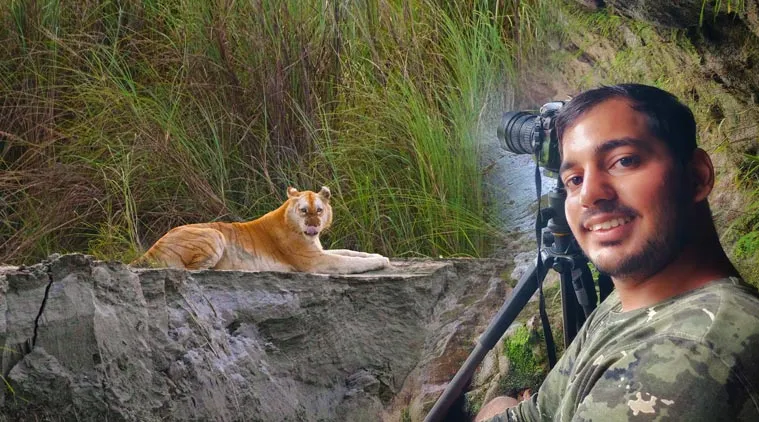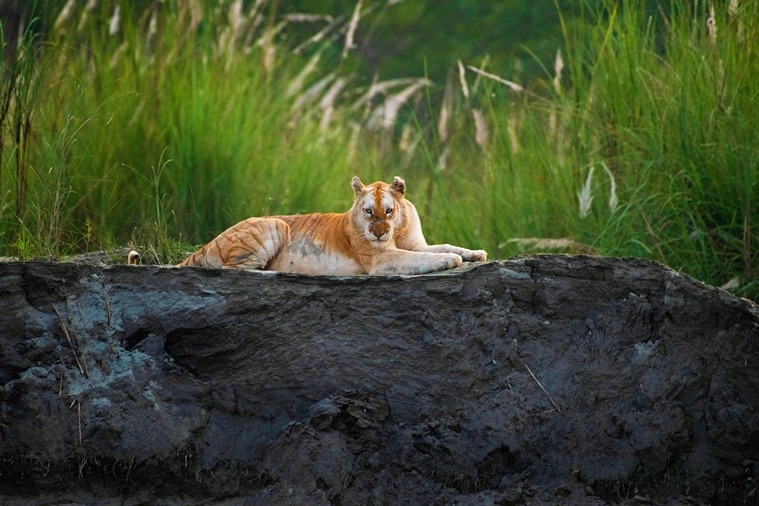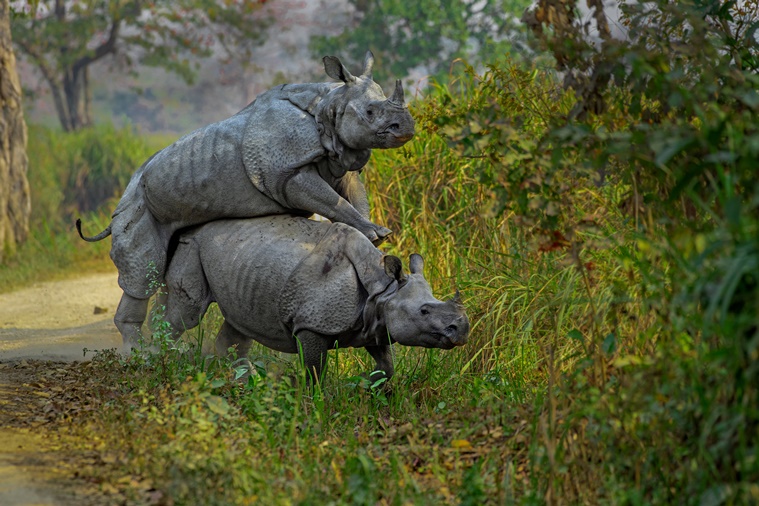 The wildlife photographer Mayuresh Hendre shares more about the big cat he captured through his lens. (Source: Mayuresh Hendre; designed by Gargi Singh)
The wildlife photographer Mayuresh Hendre shares more about the big cat he captured through his lens. (Source: Mayuresh Hendre; designed by Gargi Singh)
After receiving a lot of adulation for his 2019 photograph of Assam’s golden tigress in a rare sighting, which Indian Forest Service officer Parveen Kaswan recently tweeted, one would assume that wildlife photographer Mayuresh Kishor Hendre must be on cloud nine. However, while the 25-year-old naturalist is “glad” about the sudden recognition, he remains concerned at the rare sighting of the golden tiger, a “rare colour morph” of the famous Royal Bengal Tiger that is mostly found in India and some parts of the sub-continent.
Thane-based Hendre, who has seen the golden tigress on different occasions near Kaziranga National Park during his cruise trips to the Brahmaputra over the past two years, says lack of tiger habitats is leading to excessive inbreeding between tigers causing genetic anomalies — which is not a good news for the tiger population.
“While tigers are known to travel from one area to another in search of potential mates, in the absence of tiger habitats, the chances of inbreeding increases, which reduces the genetic diversity among tigers,” explained Hendre.
Do you know in #India we have a Golden #Tiger also. Only documentation of such big cat in 21st century on planet. This by Mayuresh Hendre. Look at this beauty. pic.twitter.com/8kiOy5fZQI
— Parveen Kaswan (@ParveenKaswan) July 10, 2020
In an interview with indianexpress.com, Hendre shares more about the rare capture through which he wants to strike a conversation on conservation, his passion for wildlife and biodiversity, and the need for tiger corridors to counter the threat to India’s rich biodiversity.
Your golden tigress photo has been receiving praise from all quarters. How do you feel?
I am overwhelmed by the response! I am happy that the photographs are making people aware of the occurrence of such a rare female Royal Bengal Tiger.
I had shared the first photos in October 2019, when I spotted the unique tigress for the first time. Wildlife lovers and photographers expressed wonder. Even Kaziranga Forest Department had reported their research on the matter on their official Facebook page. But recently, when my Instagram post about the tigress was shared by a nature-related account, IFS officer Parveen Kaswan came across it and asked if he could share it on Twitter. And that is when it went viral.
 Golden tiger is actually a golden tigress. (Source: Mayuresh Hendre)
Golden tiger is actually a golden tigress. (Source: Mayuresh Hendre)
You have sighted the majestic species on six different occasions during October-December 2019. Tell us about it.
I have been working as a naturalist and destination manager with a river cruise service since the past two years. And I have been lucky enough to explore the Brahmaputra River and Kaziranga National Park, a UNESCO World Heritage Site.
But it is extremely difficult to see a tiger in Kaziranga, let alone photograph it due to the tall elephant grass in the park. Even after visiting so many times, during the first year, I did not sight a tiger. But my luck turned around in the second year (2019) when I saw this unique tigress.
The sighting lasted for around 10 minutes only. And only once I could manage to photograph the tigress sitting on the sandbank, curiously looking at us.
Though it was quite far, I could make out the colour difference of the skin, through my photographs. I first assumed it to be some kind of an albino. When I got clearer images, I posted them on social media. And after seeing them, many tiger experts commented on it being a Tabby Tiger or Golden Tiger. After that, Kaziranga Forest Department posted a brief description about the animal.
What was your experience like?
It was an absolutely enthralling experience. The tigress was never bothered by our presence. The first time I saw it, I didn’t utter a single word, I just kept clicking. It was completely an unexpected sighting. We could observe her behaviour very closely. I noted down all the details about her behaviour, how she walks, what trails she uses, where she marks the territory, the timing of the sighting, etc. And the next time we went, we tried to match our timing with the sighting we had the previous time, and lo and behold, the tigress emerged out of the grass exactly at that time. Unhindered by our presence, she marked her territory and vanished back inside the tall grass. That was an experience of a lifetime.
Why is such a rare occurrence a matter of concern?
Golden were only known to be in zoos and breeding centres; finding them in the wild is quite rare. That’s why this sighting, and the study done by the Kaziranga Forest Department is important. This sighting is not a sign of joy, it’s a sign of utmost concern. This occurrence is believed to be caused due to recessive genes in individuals, as a result of inbreeding in the wild, because of habitat destruction and loss of connectivity of Kaziranga with other tiger areas.
 The majestic animal in Kaziranga National Park. (Source: Mayuresh Hendre)
The majestic animal in Kaziranga National Park. (Source: Mayuresh Hendre)
This is where importance of tiger corridors comes in?
Yes. Only if there are more tiger corridors, tigers can move beyond their home ranges (which they usually do) and breed with tigers in other protected areas.
A tiger corridor or a wildlife corridor is a stretch of land which links two forests or protected areas to ensure movement of tigers and other wildlife such as deer, elephants, etc. Without these corridors, tiger habitats will become isolated and fragmented. Tigers may also face localised extinction if these don’t exist. As human population in India increases, these tiger corridors which are a refuge to many wildlife species are under major threat from development projects.
As a wildlife photographer, the big cats have always fascinated you. Where does that passion come from?
It was the love for nature. And as a child I was always fascinated by the stories of Jungle Book, I vividly remember watching the animated series on DD National and the song Jungle Jungle pata chala hai. Later, keenly watching the series Earth Matters by India’s legendary wildlife filmmaker Mike Pandey inspired me a lot. I started observing birds as a child during summer holidays in my native village and later photographed butterflies using my father’s small digicam. As time progressed, this hobby became a passion as I understood more about nature through photography. Before doing this full-time, I was a media professional working in a production house in Mumbai.
For me, wildlife photography is not just about big mammals, it is about each and every aspect of biodiversity. I believe in giving importance to the smallest of insects to the biggest of animals like tigers, rhinos and elephants. Each and every animal plays its part in maintaining the balance of nature. I believe taking photographs and telling stories about nature is very important. I want to inspire people to love nature.
Is India doing enough for its nature and wildlife?
We have a wide variety of wildlife in the country, from big cats, rhinos, elephants to rare primates and colourful birds. But we are not doing enough to save this biodiversity. Man-animal conflict is at an all-time high at present. Many cases are not even reported. Climate crisis is real and is happening at an alarming rate. The government has proposed the draft EIA (Environment Impact Assessment), which is going to dilute and remove many existing regulations in place with a goal to improve the “Ease of Doing Business”.
Can you also talk about other animals you have photographed or would like to?
 One-Horned Indian Rhinos. (Source: Mayuresh Hendre)
One-Horned Indian Rhinos. (Source: Mayuresh Hendre)
Working in Kaziranga National Park and Assam for two years gave me lot of opportunities to photograph wildlife there. I photographed the One-Horned Indian Rhino, the Indian Elephant, the Eastern Swamp Deer, Wild Water Buffaloes. I also went to look for rare primates like the Endangered Golden Langurs and the Western Hoolock Gibbons, the only ape found in India. It was a treat to watch and photograph them. I also made a Vlog about the Golden Langurs, which can only be found in Assam and some parts of Bhutan. I travelled to the Western Ghats to photograph some rare and endangered frogs which are endemic to it, meaning they are found nowhere else on Earth. I explored the Himalayas and photographed the elusive Red Panda, one of my favourite animals. I would really like to photograph two big cats – The Snow Leopard and The Black Panther.
Given the pandemic right now and lockdown of such locales, how are you spending your time?
Many of my plans to explore the beautiful jungles of India have halted. But that gave me an opportunity to explore wildlife in our urban areas. Do you know we have many wild animals and birds living close to us which have adapted to this changing urban landscape?
I tried documenting owls, Gangetic dolphins, snakes and many other colourful birds during the lockdown as well, without venturing anywhere out of my safe zone or breaking the lockdown rules. I have made vlogs about them and uploaded them on my YouTube channel – Way to the Wild. This was to show people that wildlife is everywhere, you just have to open your eyes and observe.
For more lifestyle news, follow us: Twitter: lifestyle_ie | Facebook: IE Lifestyle | Instagram: ie_lifestyle